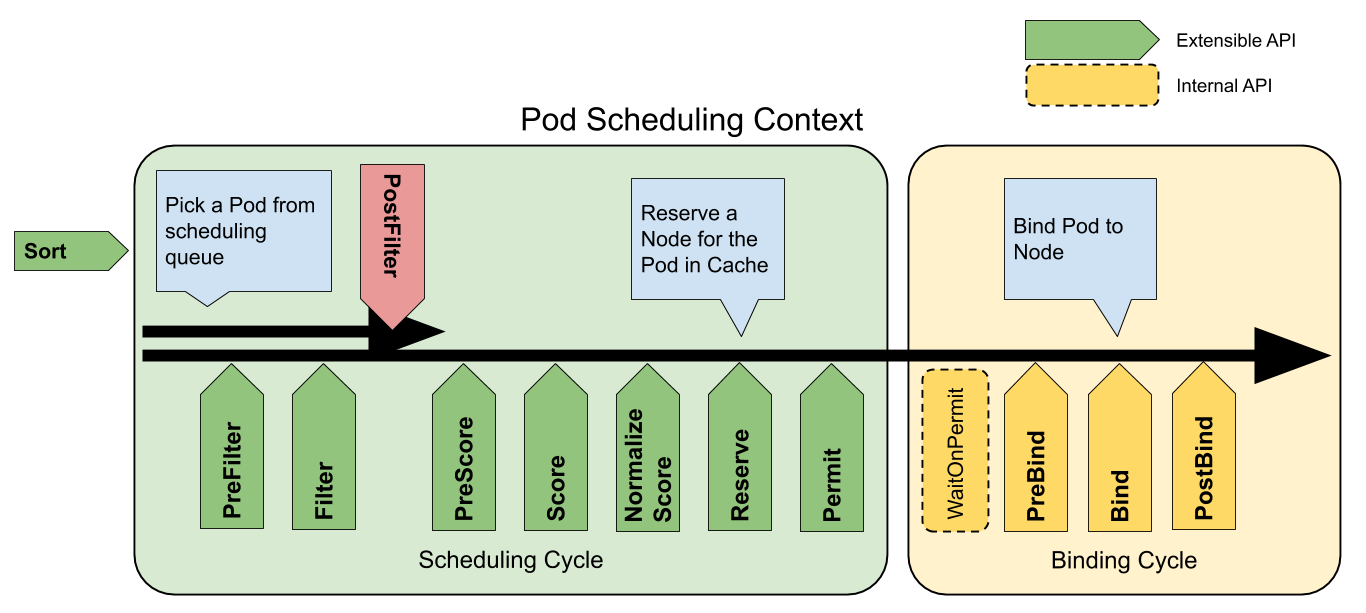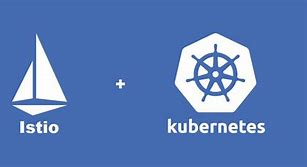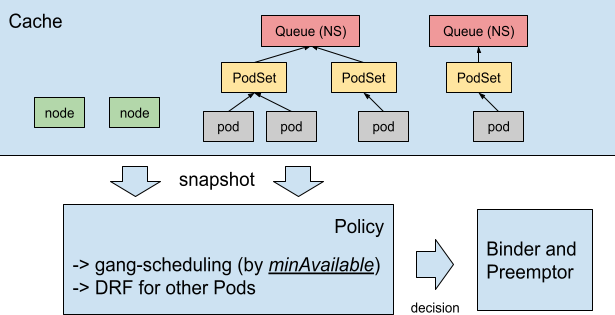需求背景 在多租户的场景下,提供一种跨namespace的资源“借用”途径,在资源池建设之后进一步提升资源的利用率。在还资源过程中,期望能够控制对原来跨ns借用资源的应用进行“延迟”释放,控制驱逐Pod的顺序,保障原来优先级较高的应用不会被优先处理。
用户故事 应用类别分为 训练任务和在线任务。Pod副本数是可以适当弹性浮动的,即比如副本数为3~6之间都可以接受。在线服务可以理解为服务可能在用户开通之后就一直存在,客观情况下除非用户主动删除在线服务,否则在资源满足的情况下不会主动释放其占用的服务。简单描述即当资源可能不够的情况下,在需要自动释放资源的时候,在线服务是 “延迟” 释放资源,优先对那些训练任务“动手”。
用户A配置了 {resources:{min:6, max:10}} 的资源限额,用户B的资源限额配置为 {resources: {min:12,max:14}}
用户A Job 应用资源配置为{resources:{requests:2,limits:2}} rs为2,NoteBook 应用资源配额为{resources:{requests:2,limits:2}} rs 为2
用户B Job-1 应用资源配置为{resources:{requests:3,limits:3}} rs为1,Job-2 应用资源配置为{resources:{resources:5,limits:5}} rs为1。
背景如上,模拟过程步骤及期望如下:
在ns-A中运行Job,在ns-B中运行Job-1,由于此时requests都没有达到min值,此时在各自的ns中都能正常运行。
在ns-A中运行NoteBokk服务,这个时候 2*2+2*2>6那么需要向ns-B借用部分资源进行运行
在ns-B中运行Job-2服务,这个时候ns-B通知ns-A:”大兄嘚,临时借用的资源该还我了,”,此时在ns-A中,由于NoteBook服务是在线服务,需要保障其在 “不得已” 情况下才释放资源以备还回借用的资源,此时应该是优先释放Job 资源来还债。
需求解析
跨namespace资源借用
控制pod释放资源的先后顺序。
以下情况举例以CPU资源为例,Memory,GPU一样适用
跨namespace资源调用 解决方案: 基于scheduler framework 定义 capacityScheduling 调度策略。scheduler frameworkPoints逻辑,详细的代码分析后续分析scheduler framework进行介绍 。
控制资源释放的先后顺序 解决方案: 基于PriorityClass的优先级与抢占式,PriorityClass优先级与抢占
优先级的概念我们都可以理解,即优先级越高则优先抢占资源,固引入对NoteBook关联的PriorityClass的定义:
1 2 3 4 5 6 7 apiVersion: scheduling.k8s.io/v1 kind: PriorityClass metadata: name: priority-class-for-notebook value: 1000000 globalDefault: false description: "This priority class should be used for notebook service pods only.
注意,这是一个全局性质的定义,不会因为namespace而控制。
那怎么知道还资源释放是和优先级相关的呢?selectVictimsOnNode,我们可以知道这边是选择那些“倒霉蛋”来释放他们借用的资源,具体关键逻辑性的代码如下:
1 2 3 4 5 6 7 8 9 10 11 12 13 14 15 16 17 18 19 20 21 22 23 24 25 26 27 28 29 30 31 32 33 34 35 36 37 38 39 40 41 42 43 44 45 46 47 48 49 50 51 52 53 54 ... // 此处自定义了排序逻辑 sort.Slice(nodeInfo.Pods, func(i, j int) bool { return !util.MoreImportantPod(nodeInfo.Pods[i].Pod, nodeInfo.Pods[j].Pod) }) var potentialVictims []*v1.Pod if preemptorWithElasticQuota { for _, p := range nodeInfo.Pods { pElasticQuotaInfo, pWithElasticQuota := elasticQuotaInfos[p.Pod.Namespace] if !pWithElasticQuota { continue } if moreThanMinWithPreemptor { // If Preemptor.Request + Quota.Used > Quota.Min: // It means that its guaranteed isn't borrowed by other // quotas. So that we will select the pods which subject to the // same quota(namespace) with the lower priority than the // preemptor's priority as potential victims in a node. if p.Pod.Namespace == pod.Namespace && podutil.GetPodPriority(p.Pod) < podPriority { potentialVictims = append(potentialVictims, p.Pod) if err := removePod(p.Pod); err != nil { return nil, 0, false } } } else { // If Preemptor.Request + Quota.allocated <= Quota.min: It // means that its min(guaranteed) resource is used or // `borrowed` by other Quota. Potential victims in a node // will be chosen from Quotas that allocates more resources // than its min, i.e., borrowing resources from other // Quotas. if p.Pod.Namespace != pod.Namespace && moreThanMin(*pElasticQuotaInfo.Used, *pElasticQuotaInfo.Min) { // 将选择好的 POD 添加到Victims数组中 potentialVictims = append(potentialVictims, p.Pod) if err := removePod(p.Pod); err != nil { return nil, 0, false } } } } } else { for _, p := range nodeInfo.Pods { _, pWithElasticQuota := elasticQuotaInfos[p.Pod.Namespace] if pWithElasticQuota { continue } if podutil.GetPodPriority(p.Pod) < podPriority { potentialVictims = append(potentialVictims, p.Pod) if err := removePod(p.Pod); err != nil { return nil, 0, false } } } }
我们再来看看 util.MoreImportantPod 这个排序的具体逻辑:
1 2 3 4 5 6 7 8 func MoreImportantPod(pod1, pod2 *v1.Pod) bool { p1 := podutil.GetPodPriority(pod1) p2 := podutil.GetPodPriority(pod2) if p1 != p2 { return p1 > p2 } return GetPodStartTime(pod1).Before(GetPodStartTime(pod2)) }
到了这边就一切了然了,实际上优先根据优先级排序,如果优先级相同的话则根据StartTime进行排序。
至此算完成了 ,但是果真如此么?这里我们引入了PriorityClass来控制释放资源的顺序,那么会不会引入其他问题呢?
谨惕 Pod一直处于“资源饥饿”状态,始终没法部署运行。那么我们有没有机会在利用优先级的同时,弱化抢占的行为能力呢?答案是肯定的,官方文档中有关于非抢占式的 PriorityClass 的明细描述,通过以上的组合,可以达到目前我们的需求预期,下面让我们来验证测试。
验证测试 测试环境为kube-scheduler 编译完成之后需要对kube-scheduler配置对应的调度策略:
1 2 3 4 5 6 7 8 9 10 11 12 13 14 15 16 17 18 19 20 21 22 23 24 25 26 27 28 29 30 31 32 33 34 35 36 37 38 39 40 41 42 43 44 45 46 47 48 49 50 51 52 53 54 55 56 57 58 59 60 61 62 63 64 65 66 67 # kube-scheduler.yaml apiVersion: v1 kind: Pod metadata: creationTimestamp: null labels: component: kube-scheduler tier: control-plane name: kube-scheduler-with-plugins namespace: kube-system spec: containers: - command: - kube-scheduler - --authentication-kubeconfig=/etc/kubernetes/scheduler.conf - --authorization-kubeconfig=/etc/kubernetes/scheduler.conf - --bind-address=127.0.0.1 // modify - --config=/etc/kubernetes/scheduler-plugins/sched-multi.yaml - --port=0 image: kirago/kube-scheduler:v0.19.8 imagePullPolicy: IfNotPresent livenessProbe: failureThreshold: 8 httpGet: host: 127.0.0.1 path: /healthz port: 10259 scheme: HTTPS initialDelaySeconds: 10 periodSeconds: 10 timeoutSeconds: 15 name: kube-scheduler-with-plugins resources: requests: cpu: 100m startupProbe: failureThreshold: 24 httpGet: host: 127.0.0.1 path: /healthz port: 10259 scheme: HTTPS initialDelaySeconds: 10 periodSeconds: 10 timeoutSeconds: 15 volumeMounts: - mountPath: /etc/kubernetes/scheduler.conf name: kubeconfig readOnly: true // modify - mountPath: /etc/kubernetes/scheduler-plugins/sched-multi.yaml name: sched-multi readOnly: true hostNetwork: true priorityClassName: system-node-critical volumes: - hostPath: path: /etc/kubernetes/scheduler.conf type: FileOrCreate name: kubeconfig // modify - hostPath: path: /etc/kubernetes/scheduler-plugins/sched-multi.yaml type: FileOrCreate name: sched-multi status: {}
1 2 3 4 5 6 7 8 9 10 11 12 13 14 15 16 17 18 19 20 21 22 23 24 25 26 27 28 # sched-multi.yaml apiVersion: kubescheduler.config.k8s.io/v1beta1 kind: KubeSchedulerConfiguration leaderElection: leaderElect: false clientConnection: kubeconfig: /etc/kubernetes/scheduler.conf profiles: - schedulerName: default-scheduler plugins: preFilter: enabled: - name: CapacityScheduling postFilter: enabled: - name: CapacityScheduling disabled: - name: "*" reserve: enabled: - name: CapacityScheduling postBind: enabled: # pluginConfig is needed for coscheduling plugin to manipulate PodGroup CR objects. pluginConfig: - name: CapacityScheduling args: kubeConfigPath: /etc/kubernetes/scheduler.conf
*由于 scheduler plugins*是sig-scheduling维护,目前这块的文档还是比较少的,这边的插件目前属于out-of-tree,这边的Option是merge到in-tree中的,所以每个Point该怎么配,最直观的就是看下源码,这是最靠谱的,之前在陪coScheduling的时候就遇到一丢丢问题,个人也提交了个ISSUE确认了下,详见The Pod of kube-scheduler : "found unknown field: unreserve"
权限准备工作 1 2 3 4 5 6 7 8 9 10 11 12 13 14 15 16 17 18 19 20 21 22 23 24 25 // all-in-one.yaml # First part # Apply extra privileges to system:kube-scheduler. kind: ClusterRole apiVersion: rbac.authorization.k8s.io/v1 metadata: name: system:kube-scheduler:plugins rules: - apiGroups: ["scheduling.sigs.k8s.io"] resources: ["elasticquotas"] verbs: ["get", "list", "watch", "create", "delete", "update", "patch"] --- kind: ClusterRoleBinding apiVersion: rbac.authorization.k8s.io/v1 metadata: name: system:kube-scheduler:plugins roleRef: apiGroup: rbac.authorization.k8s.io kind: ClusterRole name: system:kube-scheduler:plugins subjects: - apiGroup: rbac.authorization.k8s.io kind: User name: system:kube-scheduler ---
创建对应的namespace 1 2 3 4 5 6 7 8 9 10 11 12 // eq-ns.yaml // ns-A apiVersion: v1 kind: Namespace metadata: name: eq1 --- // ns-B apiVersion: v1 kind: Namespace metadata: name: eq2
创建CRD文件 1 2 3 4 5 6 7 8 9 10 11 12 13 14 15 16 17 18 19 20 21 22 23 24 25 26 27 28 29 30 31 32 33 34 35 36 37 38 39 40 41 42 43 44 45 46 47 48 49 50 51 52 53 54 55 // capacityscheduler-crd.yaml apiVersion: apiextensions.k8s.io/v1 kind: CustomResourceDefinition metadata: name: elasticquotas.scheduling.sigs.k8s.io annotations: "api-approved.kubernetes.io": "https://github.com/kubernetes-sigs/scheduler-plugins/pull/52" spec: group: scheduling.sigs.k8s.io names: plural: elasticquotas singular: elasticquota kind: ElasticQuota shortNames: - eq - eqs scope: Namespaced versions: - name: v1alpha1 served: true storage: true schema: openAPIV3Schema: type: object properties: spec: type: object properties: min: type: object additionalProperties: anyOf: - type: integer - type: string pattern: ^(\+|-)?(([0-9]+(\.[0-9]*)?)|(\.[0-9]+))(([KMGTPE]i)|[numkMGTPE]|([eE](\+|-)?(([0-9]+(\.[0-9]*)?)|(\.[0-9]+))))?$ x-kubernetes-int-or-string: true max: type: object additionalProperties: anyOf: - type: integer - type: string pattern: ^(\+|-)?(([0-9]+(\.[0-9]*)?)|(\.[0-9]+))(([KMGTPE]i)|[numkMGTPE]|([eE](\+|-)?(([0-9]+(\.[0-9]*)?)|(\.[0-9]+))))?$ x-kubernetes-int-or-string: true status: type: object properties: used: type: object additionalProperties: anyOf: - type: integer - type: string pattern: ^(\+|-)?(([0-9]+(\.[0-9]*)?)|(\.[0-9]+))(([KMGTPE]i)|[numkMGTPE]|([eE](\+|-)?(([0-9]+(\.[0-9]*)?)|(\.[0-9]+))))?$ x-kubernetes-int-or-string: true
创建NoteBook关联的PriorityClass 1 2 3 4 5 6 7 8 apiVersion: scheduling.k8s.io/v1 kind: PriorityClass metadata: name: priority-class-for-notebook value: 1000000 preemptionPolicy: Never globalDefault: false description: "This priority class should be used for notebook service pods only."
模拟场景所需的Deployment 1 2 3 4 5 6 7 8 9 10 11 12 13 14 15 16 17 18 19 20 21 22 23 24 25 26 27 28 // Job apiVersion: apps/v1 kind: Deployment metadata: name: nginx1-1 namespace: eq1 labels: app: nginx1-1 spec: replicas: 2 selector: matchLabels: app: nginx1-1 template: metadata: name: nginx1-1 labels: app: nginx1-1 spec: containers: - name: nginx image: nginx command: ["/bin/bash", "-c", "cat /dev/urandom | gzip -9 | gzip -d | gzip -9 | gzip -d > /dev/null"] resources: limits: cpu: 2 requests: cpu: 2
1 2 3 4 5 6 7 8 9 10 11 12 13 14 15 16 17 18 19 20 21 22 23 24 25 26 27 28 29 30 31 // NoteBooK apiVersion: apps/v1 kind: Deployment metadata: name: nginx2-1 namespace: eq1 labels: app: nginx2-1 spec: replicas: 2 selector: matchLabels: app: nginx2-1 template: metadata: name: nginx2-1 labels: app: nginx2-1 annotations: job: notebook spec: containers: - name: nginx image: nginx command: ["/bin/bash", "-c", "cat /dev/urandom | gzip -9 | gzip -d | gzip -9 | gzip -d > /dev/null"] resources: limits: cpu: 2 requests: cpu: 2 priorityClassName: priority-class-for-notebook
1 2 3 4 5 6 7 8 9 10 11 12 13 14 15 16 17 18 19 20 21 22 23 24 25 26 27 28 // Job 1 apiVersion: apps/v1 kind: Deployment metadata: name: nginx1-2 namespace: eq2 labels: app: nginx1-2 spec: replicas: 1 selector: matchLabels: app: nginx1-2 template: metadata: name: nginx1-2 labels: app: nginx1-2 spec: containers: - name: nginx image: nginx command: ["/bin/bash", "-c", "cat /dev/urandom | gzip -9 | gzip -d | gzip -9 | gzip -d > /dev/null"] resources: limits: cpu: 3 requests: cpu: 3
1 2 3 4 5 6 7 8 9 10 11 12 13 14 15 16 17 18 19 20 21 22 23 24 25 26 27 28 // Job-2 apiVersion: apps/v1 kind: Deployment metadata: name: nginx2-2 namespace: eq2 labels: app: nginx2-2 spec: replicas: 1 selector: matchLabels: app: nginx2-2 template: metadata: name: nginx2-2 labels: app: nginx2-2 spec: containers: - name: nginx image: nginx command: ["/bin/bash", "-c", "cat /dev/urandom | gzip -9 | gzip -d | gzip -9 | gzip -d > /dev/null"] resources: limits: cpu: 5 requests: cpu: 5
部署 Job
部署 Job-1
部署 NoteBook,此时模拟ns-A按照我们的预期 2*2+2*2>6,且 ns-B 空间用户的资源还有剩余满足借用的前提,即使 8>6 但是也是能够将ns-A中所有的应用部署起来的。
部署模拟 ns-B 中的Job-2,此时这个时候ns-B肯定会优先保障自家兄弟的温饱,此时ns-A中借用的资源应该还回来了,但是应该还谁的资源呢?根据上文的分析实际上再ns-A中也分三六九等,需要优先保障NoteBook服务,那么就是对Job进行下手。
可以看到,一切按照我们的预期在执行,至此,各位大佬可以发现,此处的pod nginx1-1-59457d7fbf-4pkxt是一个pending状态,为啥不是直接被干掉呢?
后续更新源码分析










